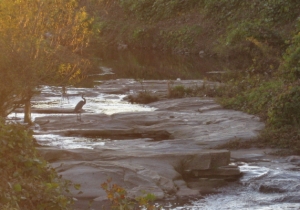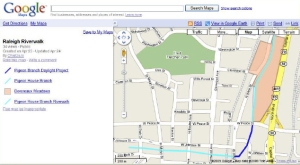Walnut Creek Wetland Park is approximately 59 acres in size and is located between Garner Road and South State Street and south of Peterson Street in Southeast Raleigh. This site contains extensive wetlands that are located near the downtown urban center and offer an opportunity for the public to easily explore and learn about the value and significance of wetlands for water quality and wildlife habitat. Raleigh City website
Construction has begun on the Walnut Creek Wetland Center, as reported in NandO on February 11. The center is the culmination of efforts led by Norman Camp to rehabilitate and protect the wetlands of Raleigh’s Southeast. This topo map shows the area. The new building, shown below, was designed by Frank Harmon, and will stand six feet above the ground and have a minimal ecological footprint. An earlier post describes some amenities of this section of greenway.
*************
The groundhog definitely saw his shadow, but early signs of spring abound in Raleigh. Above is henbit between Hodge Road and Crabtree. Below are red maples blossoms in Oakwood. There is some cold air coming, so there will be some casualties – though our well-mulched garden parsley and “spinach under glass” on the deck are doing great!
*************
One of the exciting things about Raleigh Nature is the wonderful reader input, and I need to follow up and post about more of it. There’s always a tension between getting around to it and doing it justice. Here are a few smoldering issues on my draft posts:
First and most behind: responding to the multiple inputs about Lassiter Mill and Raleigh mill history. From David’s great pics of the upper water, to the amazing Lassiter mill drive wheel images sent by Jimmy, and the history and memories in the comments, we need to return to this subject soon! I recently got a fascinating inquiry from Carol about the infilled Lake Boone, and the natural springs that fed it, and I want badly to follow that up. I very much appreciated the mistletoe tips from Meredith, and dream of my “pecans and mistletoe” map of Raleigh! Scott, a well-known author, my old friend Joe, and Tommy, a songwriter from my past, all greatly helped my still-unfinished exploration of the Pigeon House Branch system and the expensive new Fletcher Water Park that feeds into it. We’ve been blessed with an explanation of Raleigh Swamp’s waters by Mark, who engineered it, and we’ve been sobered by the plea for resolution from Deborah concerning Ward Transformer’s lifetime of ecological crimes against our area. I look forward to sharing Patti’s wonderful hawk story, and keeping Michiel in the Netherlands all caught up on Raleigh’s natural scene. Mentioning these highlights, many thanks to all who have written or commented. It really helps the work!
**********
Chris Crew and Matthew Brown just wrote a wonderful article about Oakwood wildlife for our neighborhood newsletter.They are neighbors at the bottom of the slope at whose crest I reside. Between my house and theirs almost every inch is controlled by humans, and the water flowing downhill is piped or culverted. Below their house, toward Brookside and Glascock, the land opens up just a bit and has some natural edges. As a matter of fact, Chris is uncovering the section of Grassy Branch in his backyard, and that’s another topic on my to-do list. Just across the road, though, is Oakwood Cemetery, a significant oasis for many living things. According to their article, our neighborhood boasts a huge variety of species. Among many bird species they describe, the cedar waxwing invasion for berries and the long-standing nest of red-tail hawks stood out. Foxes, possums, and a substantial population of raccoons are described. There are excellent nature lore tips regarding the colors of 5-lined skinks and owl sounds. I wish the newsletter were online, but if you have a friend that’s a resident, check it out. Way to go, Matthew and Chris!


















